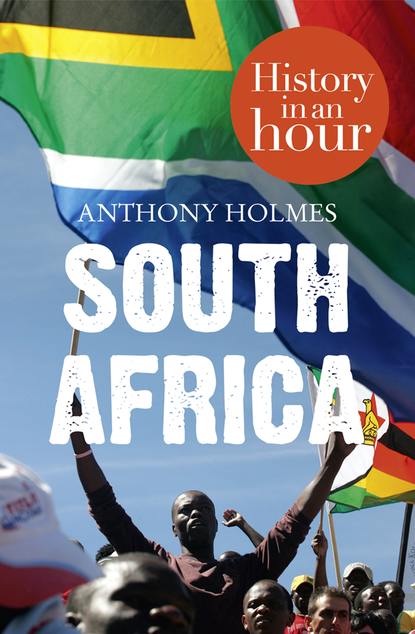По всем вопросам обращайтесь на: info@litportal.ru
(©) 2003-2024.
✖
South Africa: History in an Hour
Настройки чтения
Размер шрифта
Высота строк
Поля
Sir George Colley at Laing’s Nek
Colley gathered his force at Newcastle in Natal. His ultimatum to the Boers was rejected and Colley advanced towards the Transvaal border. The British made camp over 6 km short of Laing’s Nek, a ridge that was occupied by a Boer force. On the morning of 28 January 1881 Colley moved out with his troops. The British infantry of the time wore red jackets, blue trousers with red piping, and white pith helmets. The Boers on the other hand were a citizen militia. They had no uniforms but they were expert marksmen. The British soldiers stood out like ready-made targets on the hilly grassland of the Natal-Transvaal border region.
The 58th Regiment was led up the hillside by Lieutenant Baillie carrying the Regimental Colour and Lieutenant Hill carrying the Queen’s Colour. Baillie was mortally wounded while Hill won the Victoria Cross for bringing casualties down from the hillside.
In an endeavour to regain the initiative Colley led five hundred men to the summit of the flat-topped Majuba Hill (Hill of Doves) overlooking Laing’s Nek. Colley, apparently believing the hill was unassailable, made no provision for its defence. On the orders of the Boer commander 200 agile young men climbed Majuba Hill and with well-aimed skill devastated the unprotected British troops. Colley was killed by a Boer bullet in the ensuing action.
The British expeditionary force of 1,200 soldiers had been repulsed by the Boer forces whose numbers exceeded 3,000 and whose field tactics were better suited to the terrain. This short conflict became known as the First Boer War.
The Gold Rush
In March 1886 George Harrison, an Australian miner, literally stumbled across a rocky outcrop of a gold-bearing reef in the Transvaal. He staked his claim with the government of the Zuid Afrikaanse Republiek (ZAR). It was the greatest gold strike ever recorded. In an ironic twist of fate, Harrison is believed to have sold his claim for £10 after which he left the area and was not heard from again.
Soon the number of, mainly British, foreigners outnumbered the Boers, and by 1899 Britain was demanding that all foreigners resident in the Transvaal be granted the same political rights as Boers. In response, the President of the ZAR demanded that Britain withdraw its troops from the borders of the Transvaal within forty-eight hours failing which the Transvaal and Orange Free State Republics of South Africa would declare war on Britain. In London the news was greeted with laughter and contempt for the little upstart colony, ‘If it’s war they want, then war they will get’. And so, the second Anglo–Boer War began.
The Second Boer War (1899–1902)
Ultimately Britain was to gain the upper hand, but not before 75,000 troops and civilians had lost their lives. The final toll is estimated at 22,000 British soldiers, two thirds of whom died from disease; 7,000 Boer fighters; between 20,000 and 28,000 Boer civilians, mainly in concentration camps; and perhaps 20,000 black Africans. The British employed a scorched earth policy, burning farms, poisoning wells and covering fields with salt to deny the Boers the sustenance to continue the conflict.
Boer Guerrilla fighters
Boer women and children, and black Africans, were rounded up and placed in concentration camps where the most inhumane conditions were imposed and where many perished. These tactics won the war, but resulted in an enduring hatred of Britain by the Boers. The last of the Boers surrendered in May 1902 and the Treaty of Vereeniging was signed on 31 May 1902.
The defeat of the two Boer Republics and their consolidation with the British Cape Colony and Natal, resulted in the Act of Union of 31 May 1910 and the birth of the Union of South Africa. Each of the four unified states was allowed to keep its existing franchise qualifications. The Cape Colony was the only province which permitted adult males of any race to cast a vote, providing they owned property. The denial of the franchise to black people in the other three provinces was maintained and was to remain firmly in place for the next eighty-four years.
Founding of the ANC as SANNC in 1912
The South African Native National Congress Party (SANNC) was founded in 1912. Its goal was to maintain the voting rights of coloured males (persons of mixed race) and black Africans in the Cape Colony. The SANNC was to expand its mandate and change its name in 1923 to become the African National Congress (ANC).
The National Party of South Africa (#ulink_436904a5-a7f7-5d05-8f43-7d28481377d2)
During the First World War many Afrikaners, as the Boers became known, could not accept the concept of fighting on the side of the British against Germany. The British were still regarded by the Boers as the enemy, while Germany had supported the Boer cause. It was in this situation in 1914 that the National Party of South Africa was established by J. B. M. Hertzog in order to rally Afrikaners against the Anglicizing policy of the existing government under Louis Botha and Jan Smuts.
In 1915 South Africa invaded and conquered German South West Africa (SWA). In 1920 SWA was granted to South Africa under a C-class mandate by the League of Nations. After the dissolution of the League of Nations, SWA became the subject of a long drawn out international legal dispute that eventually resulted in the United Nations terminating the mandate in 1971. It was not until 1988, under an accord structured between South Africa, Angola and Cuba that control of SWA-Namibia was handed to the UN.
Вы ознакомились с фрагментом книги.
Приобретайте полный текст книги у нашего партнера:
Приобретайте полный текст книги у нашего партнера:






